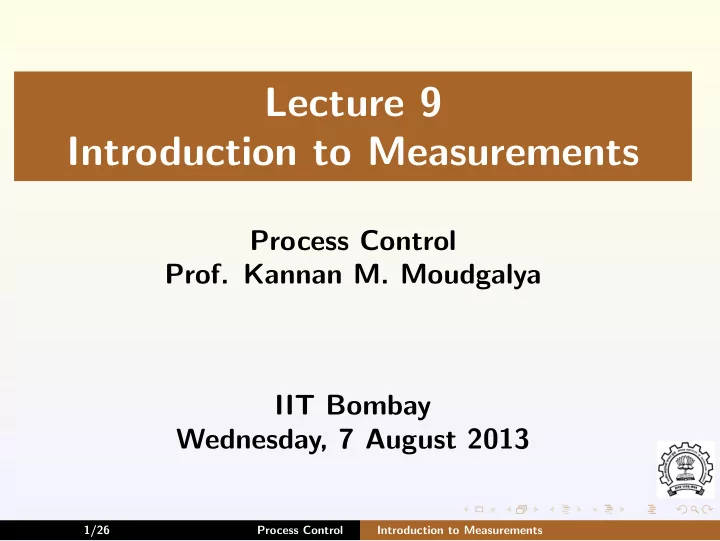

Lecture 9 Introduction to Measurements Process Control Prof. Kannan M. Moudgalya IIT Bombay Wednesday, 7 August 2013 1/26 Process Control Introduction to Measurements
Outline 1. Thermal measurements 2. Other measurements 3. About measurements 2/26 Process Control Introduction to Measurements
Outline: Components of Process Control Instrumentation System 1. Sensor/transducer 2. A/D and D/A converter 3. Transmitter 4. Feedback controller 5. End control element 3/26 Process Control Introduction to Measurements
1. Thermal Measurements 4/26 Process Control Introduction to Measurements
A Sample Control System FT Q i ( t ) Q i ( t ) FC FC LT h ( t ) h ( t ) Q ( t ) = x ( t ) h ( t ) Q ( t ) = x ( t ) h ( t ) ◮ Sensor: converts flowrate, height into voltage ◮ Transmitter ensures signal is conveyed without loss of information ◮ Red dashed lines: transmission line ◮ Controller is indicated by FC ◮ End control element is the valve 5/26 Process Control Introduction to Measurements
Distillation Column: A Control Strategy PT LT h D Coolant Exit AT Reflux, R Distillate: D , x D Feed Heat ? h B LT AT Bottoms: B , x B 6/26 Process Control Introduction to Measurements
Computer Controlled System Multiple measurements and multiple actuators 7/26 Process Control Introduction to Measurements
Temperature Sensors ◮ Thermocouple ◮ Thermistor ◮ Resistance temperature detector (RTD) ◮ Also known as resistance thermometer ◮ Pyrometer 8/26 Process Control Introduction to Measurements
Thermocouple 9/26 Process Control Introduction to Measurements
Thermocouple A thermocouple has the following useful property: 1. Very accurate, almost a reference measurement 2. Large output, voltage amplification is not required 3. Can measure large temperature ranges 4. Highly linear output, external linearisation is not required Answer: 3, large range 10/26 Process Control Introduction to Measurements
Thermistor 11/26 Process Control Introduction to Measurements
A typical bridge circuit Thermistor 1.00 k ohm 2.56 V Supply Vout 1.22 k ohm 0.29 k ohm 12/26 Process Control Introduction to Measurements
Thermistor A thermistor has the following useful property: 1. Highly sensitive in a small temperature range 2. Can measure large temperature ranges 3. Highly linear output, external linearisation is not required 4. Very accurate, almost a reference measurement Answer: 1, sensitive in small ranges 13/26 Process Control Introduction to Measurements
Resistance temperature detector (RTD) 14/26 Process Control Introduction to Measurements
RTD An RTD has the following useful property: 1. Suitable for a small temperature range only 2. Stable, accurate, repeatable 3. Highly rugged 4. Another name for this is Pt100 Answer: 2, accurate, repeatable, a standard 15/26 Process Control Introduction to Measurements
A typical bridge circuit 10 ohm 10 ohm 10 ohm RTD 100 ohm E 16/26 Process Control Introduction to Measurements
2. Other Measurements 17/26 Process Control Introduction to Measurements
Differential pressure gauge ◮ Mount one or more strain gauges ◮ Pressure difference ◮ Deflection ⇒ Stress ⇒ Strain ◮ ⇒ Change of resistance ◮ ⇒ Wheatstone bridge, ∆V 18/26 Process Control Introduction to Measurements
Flow Rate Measurement ◮ Orifice meter ◮ Venturi meter ◮ Turbine meter ◮ Thermal mass meter ◮ Heated filament in flow path ◮ Mounted on Wheatstone bridge ◮ Coriolis meter 19/26 Process Control Introduction to Measurements
Liquid level measurement ◮ Through pressure measurement ◮ Deflection of diaphragm ◮ Strain gauge based ◮ Capacitance based ◮ Time of path based ◮ Radar, ultrasound 20/26 Process Control Introduction to Measurements
3. General 22/26 Process Control Introduction to Measurements
Precision and Accuracy in Measurements ◮ Accuracy in measurements: How close a measurement is to the actual value ◮ Precision ≃ repeatability Good precision xx Poor accuracy xx y Poor precision zz zz y Good accuracy y Good precision Good accuracy 23/26 Process Control Introduction to Measurements
Accuracy and Error ◮ The word accuracy is misused ◮ ± 5% accuracy actually means ± 5% inaccuracy ◮ Error: difference between actual and measured ◮ Can be given as %FS - full scale ◮ or as %RTI - referred to input 24/26 Process Control Introduction to Measurements
Items of Interest in a Sensor 1. Measurement range (Span) 2. Sensitivity 3. Response time 4. Accuracy, repeatability 5. Reliability 6. Materials of construction 7. Electrical classification (e.g. explosive, etc.) 8. Invasive/Non invasive 9. Cost 25/26 Process Control Introduction to Measurements
Standard instrumentation signal levels 1. 3-15 psig (pneumatic) 2. 1-5 mA 3. 4-20 mA (most popular) 4. 10-50 mA 5. 0-5 Voltage, DC (VDC) 6. ± 10 V, DC 26/26 Process Control Introduction to Measurements
Sensor/Transducer, Transmitter ◮ Sensor/Transducer ◮ To sense physical variables: pressure, flow rate, temperature, etc. ◮ Convert into electrical quantity ◮ Transmitter ◮ Raises levels to suitable strength ◮ to prevent loss of information during transmission 27/26 Process Control Introduction to Measurements
What we learnt today ◮ Measurements 28/26 Process Control Introduction to Measurements
Thank you 29/26 Process Control Introduction to Measurements
Recommend
More recommend